Growing ginger at home is easier than most people think, and the plant doesn’t require any special care.
The key to success is to give it the environment it needs to thrive, and that is not difficult once you know how.
In this post you’ll learn all you need to know about ginger plant care. From planting and location, to watering, sunlight, soil, fertilizer, pest control, harvesting, troubleshooting problems, and so much more.
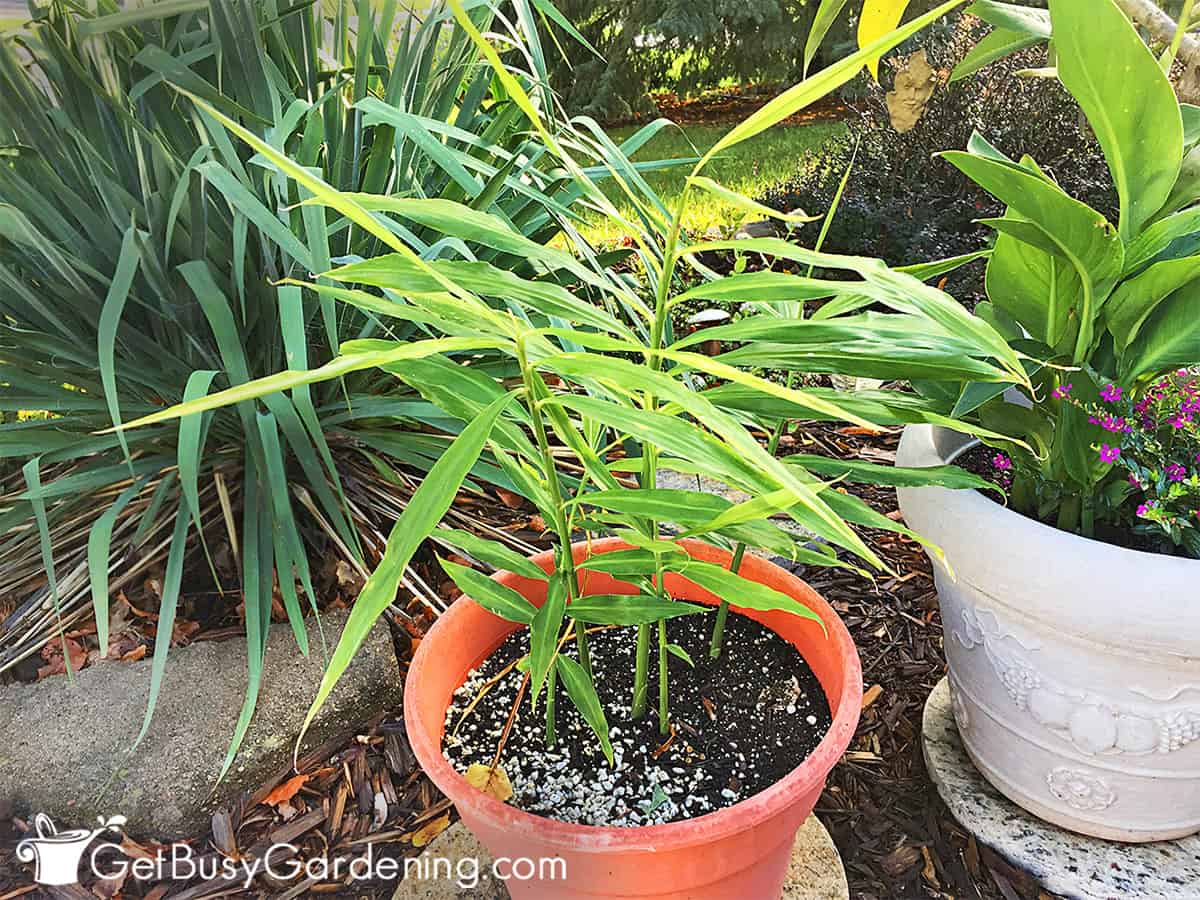
Quick Ginger Plant Care Overview
| Scientific name: | Zingiber officinale |
| Classification: | Herb |
| Common names: | Ginger |
| Hardiness: | Zones 8-10 |
| Temperature: | 65-85°F |
| Flowers: | Bloom color and timing depends on the variety |
| Light: | Full sun to partial shade |
| Water: | Consistently moist soil, do not overwater |
| Humidity: | High humidity |
| Fertilizer: | General purpose plant food in spring and summer |
| Soil: | Fast-draining, fertile soil |
| Common pests: | Aphids, mealybugs, cutworms |
Information About Ginger Plants
Ginger (Zingiber officinale) is a zesty and fragrant staple in many dishes. This culinary spice is native in Southeast Asia.
The term “ginger root” is a bit misleading because it is not a root or a bulb, but technically a rhizome.
Although the rhizome is the edible portion, the foliage and flowers also make them beautiful specimen plants.
The stems can grow up to 4’ tall fairly quickly, but it takes several months for the rhizomes to develop into a harvestable size.
Different Types
There are hundreds of types of ginger, but they all require the same basic care. Some are great for cooking, while others are best grown as ornamental or flowering plants.
They all look fairly similar above the ground, though some have wider leaves than others. Most varieties have green leaves, but they can be variegated.
The rhizome flesh can range in color from white to red, yellow, light brown, or cream. Below are a few good options for you to try.
Best Types To Eat
- Common Ginger (Zingiber officinale)
- Japanese (Zingiber mioga)
- ‘Milky Way’ (Zingiber niveum)
- Wild Ginger (Zingiber vinosum)
Ornamental Flowering Varieties
- Shell (Alpinia zerumbet)
- Butterfly (Hedychium coronarium)
- Red Bamboo (Alpinia luteocarpa)
- Ginger Lily (Alpinia japonica)
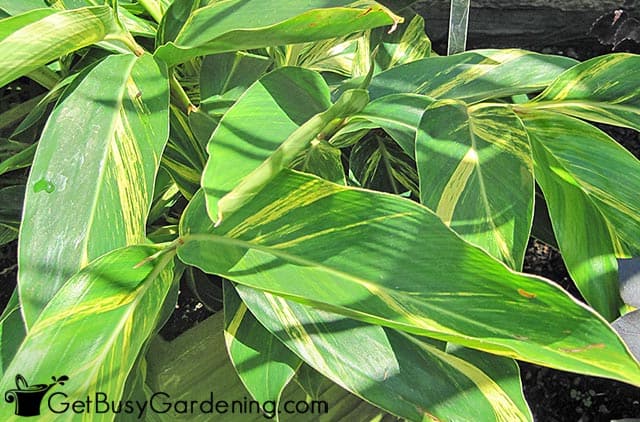
Hardiness
Though most people only know it as a culinary spice, ginger is a perennial plant in its native environment. It’s hardy in zones 8-10, so you can grow it in your garden if you live in a warm climate.
Even though it’s a tropical plant, it’s fairly easy to grow in cold climates too. Simply keep it in a container that you can put outdoors in the summer, and bring it indoors during the cooler months.
Flowers
Many types of ginger plants will flower with the proper care. The blossoms are beautiful and exotic, and can also be very fragrant.
The flowers grow in clusters of white to pink, and the more mature blooms take on a yellowish hue. In addition to being gorgeous, the buds are edible, and can add delicate flavor to teas, stocks, or soups.
How Does Ginger Grow?
The ginger that we all know and love to eat grows underground as rhizomes, which are modified horizontal stems as opposed to roots or bulbs.
These rough, tan, finger-like structures will continue to get larger and spread outward as the plant matures, and will eventually form dense clumps. You can harvest them all at once or as needed.
Where To Grow Ginger Plants
The first step toward successfully growing ginger at home is selecting the right location. It requires fertile soil, high humidity, and mild temperatures.
Outdoors, find an area where the plant will be protected from direct afternoon sunlight and high winds. Choose a spot in your garden that has good drainage, and where the water doesn’t pool.
It also does very well in a pot, which is where you should grow it if you live in a cold climate. Then you can put it outside during the summer, and move it indoors for the winter.
Related Post: 13 Best Herbs To Grow Indoors
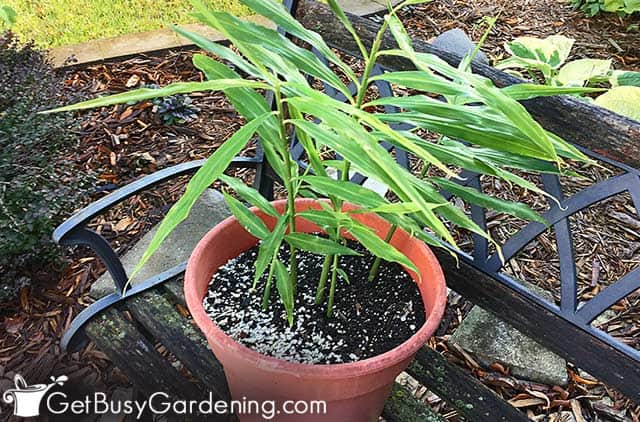
When To Plant Ginger Root
If you live in a warm climate where it can grow year round, it’s best to plant your ginger in the spring.
Otherwise, if you live someplace cold, then you should start the rhizomes indoors sometime in late January or early February.
Before planting it into the ground, use a soil thermometer to check that the temperature is at least at least 60°F. If it’s too cold, it will stunt their growth or the rhizomes could end up rotting.
Ginger Care & Growing Instructions
Growing ginger requires starting it at the right time, and caring for it by providing plenty of warmth, humidity, and fertile soil. Below, I’ll give you all the details for success.
Water
Ginger plants need regular watering, but the soil should never be wet or saturated. Overwatering will cause the rhizomes to rot.
On the flip side, you should never allow it to dry out completely either, because drought can trigger dormancy. It’s best to allow the top inch to dry out between waterings, and then give the plant a good drink.
If yours is in a pot, wait until water starts running out of the bottom holes. Then allow it to drain completely before placing it back on the drip tray.
It can be a delicate balance, so you may want to get yourself an inexpensive moisture gauge to make it easy for you to get it right.
Humidity
One of the biggest struggles of successful ginger plant care, especially indoors, is giving it enough humidity. Since the plant is native to the subtropics, the ideal environment is warm and humid conditions.
If the air is too dry, then the leaf margins and tips will turn brown. There are a few ways that you could emulate the high humidity conditions of its native habitat.
You could regularly spritz the leaves, place the pot on a pebble tray filled with water (never allow it to soak though), or run a humidifier in the room.
Soil
The best type of soil for growing ginger is one that is fertile, rich in organic matter, and also drains fairly quickly.
Poor quality dirt can be too heavy, lack the necessary nutrients, or hold too much moisture which can inhibit growth or cause the rhizomes to rot.
Your garden soil should be soft and workable, so be sure to loosen it up really well before planting. I recommend amending hard clay or sandy beds with compost or worm castings.
Use a high quality potting soil for containers. To improve drainage, you could add some perlite or pumice into the mix.
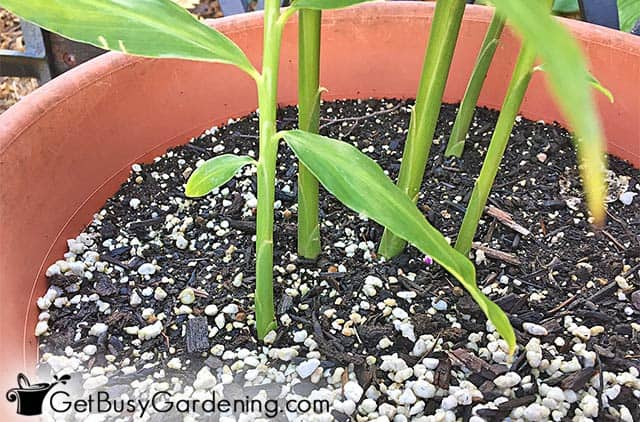
Temperature
Since they come from the tropics, ginger plants can’t handle major temperature shifts. They will grow best in an environment that stays between 65-85°F.
They’re more tolerant of heat than they are of cold. But extreme temps on either end of the spectrum will cause the plant to go dormant, especially if it’s dry.
Anything below 45°F for an extended period will begin to damage the foliage, and if the ground freezes, it will kill the rhizomes.
Fertilizer
Ginger is a heavy feeder, and requires regular fertilizer. For best results, incorporate slow-release granules into the soil before planting. Then use it to top-dress your plants 2-3 times during the summer.
Once it starts sprouting, use a liquid fertilizer weekly to maintain healthy growth. They love fish emulsion (outdoors only) and compost tea (which you can buy in a concentrate, or use tea bags to brew it yourself).
Stop fertilizing a month or so before you plan to harvest. If you want to overwinter your plant indoors, then don’t feed it at all during the fall and winter months.
Sunlight
Outside in the garden, ginger plants prefer filtered sunlight or partial shade. Choose a spot where they will get 4 to 5 hours of morning and evening sun, or indirect, dappled sunlight throughout the day.
Inside is a different story. It’s hard to give your plant too much sun indoors, especially during the winter months. So, place it in a south facing window or add a grow light.
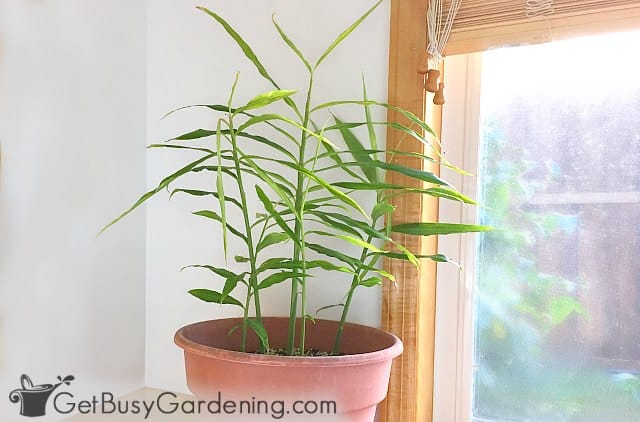
Pruning
One of the things that makes it so easy to care for is that you don’t have to worry about pruning your ginger plant. But you can trim off any brown or yellow leaves, tips, or margins at any time, if necessary.
If you live in a climate where they naturally go dormant, then cut your plant all the way down to the ground after the foliage has died back.
Pest Control
One of the best things about growing ginger is that it’s naturally resistant to pests. Although it’s fairly uncommon, sometimes bugs can become a problem.
If bugs do start eating your plants, then wash the leaves with an organic insecticidal soap. Or try making your own by mixing one tsp mild liquid soap with one liter of water.
Always be sure to test any type of spray on a few leaves before using it on the whole plant, to make sure it won’t damage the foliage.
Dormancy
Ginger naturally goes through a period of dormancy during the winter, or the drier months of the year. So, if you want to use it for cooking, then harvest it once the plant begins to die back in the fall, and put the rhizomes in the fridge.
Otherwise, you can overwinter it indoors as a houseplant. Place it in a sunny window, and keep the soil evenly moist. It may still decide to go dormant, so don’t panic if the foliage dies back.
In that case, stop watering, and store the pot in a cool, dark location until late winter. Or you can dig up the rhizomes, and store them as you would other tropical bulbs.
Tips For Harvesting Ginger
Ginger takes at least 220 days to develop to a harvestable size. But the more time you give it to mature, the better.
If you plant them in early February, you can expect to harvest in late October, or sometime in November.
Harvesting is easy, you just need to dig up the rhizomes. Take care not to cut or damage them while digging them up though. And be sure to save some to replant next year.
You can use it fresh right away, or save it for later. It will keep in the refrigerator for several weeks, or you can freeze it for up to six months.
Troubleshooting Common Ginger Care Problems
The hardest part about ginger care is when your plant starts having problems, and you have no idea how to fix it. To help you troubleshoot, here’s how to fix some common issues that you may run into…
Brown Leaf Tips & Margins
When the tips and/or edges of the leaves turn brown, that means the air is too dry. This is usually only a problem indoors.
Try regular misting, moving it to a sunny kitchen or bathroom, or run a humidifier nearby to give it more humidity.
Leaves Are Turning Yellow Or Brown
Yellow or brown leaves is usually the first sign that the plant is going into dormancy. The leaves will eventually dry up and die back, which is normal. However, it could be from overwatering, so be sure to check the soil.
Once dormancy starts, the best thing to do is to either move the pot into a dark location, or dig up and either use or store the rhizomes for a few months. To prevent it from happening, never allow the soil to dry out completely and keep the temperature between 60-85°F.
Ginger Plant Is Dying
Many times the plant is going dormant rather than dying, which is normal during the winter or periods of drought.
However, overwatering can cause the rhizomes to rot, which will kill the plant. Check the soil moisture level, and adjust accordingly. You should let it dry 1″ deep between each drink.
Brown And/Or Yellow Spots On Leaves
Spots on the leaves could be caused by too much sun, fertilizer burn, or disease. If it’s in the full sun, then move it to a shadier location.
Only use organic plant food (rather than synthetic chemicals) to prevent fertilizer burn. Dig up and discard plants.
Leaves Suddenly Turn Black
When ginger leaves turn black, that means the plant was exposed to either freezing or extremely hot temperatures.
Check the location to ensure it’s not sitting near a cold drafty door or window, or next to a heat source like a fireplace or oven.
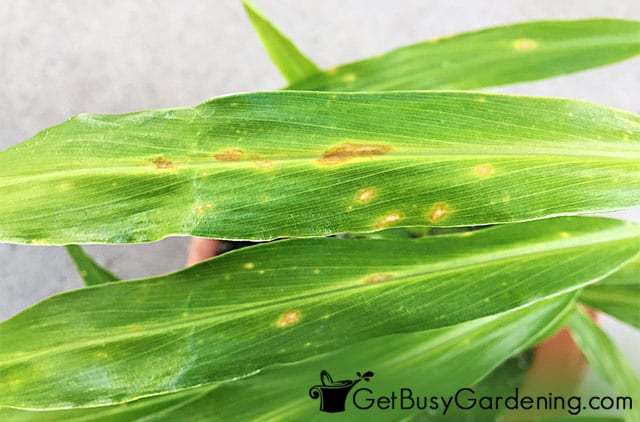
Ginger Plant Care FAQs
It can take 30-45 weeks to grow ginger into a harvestable size. The longer you let the plant grow, the larger your harvest will be.
The short answer is yes. But, many grocers treat store-bought rhizomes with chemicals to prevent sprouting. Soaking them overnight can help to break down these chemicals, but they could still inhibit growth. For best results, I recommend buying organic ginger root that hasn’t been treated with any chemicals.
No. Ginger plants grow best in a partial shade location, where they will get 4-5 hours of indirect sunlight. Too much direct sun will burn their leaves.
More Herb Gardening Posts
- How To Grow Herbs Indoors: The Ultimate Guide
- How To Fertilize Herbs In The Organic Garden
- How To Grow Cilantro (Coriander) Plants
- How To Grow Rosemary: The Ultimate Guide
Share your ginger plant care tips in the comments section below.

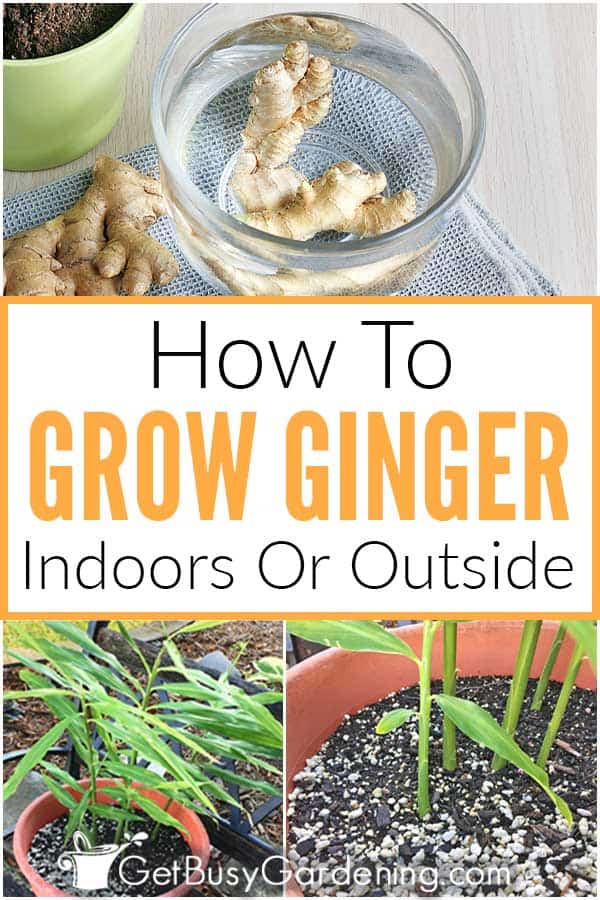
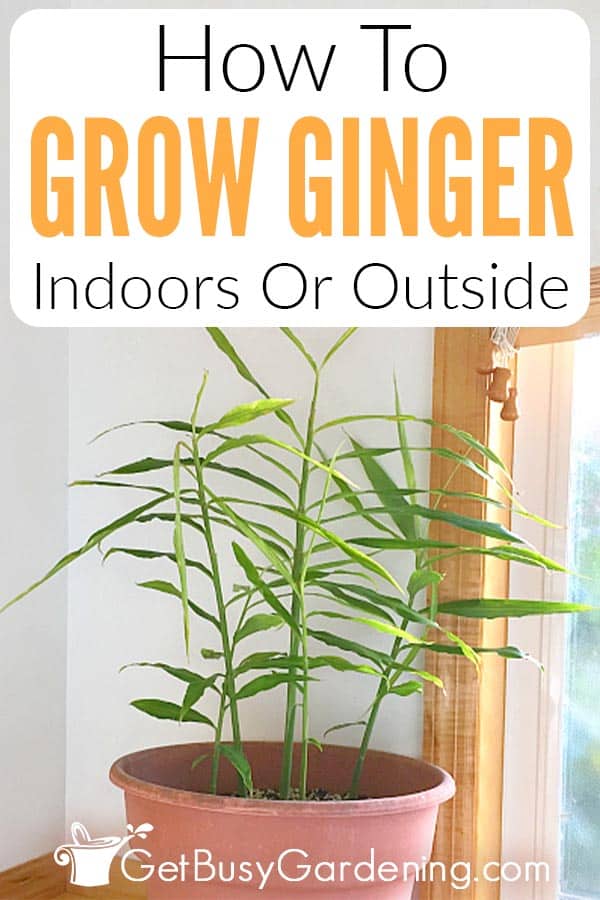
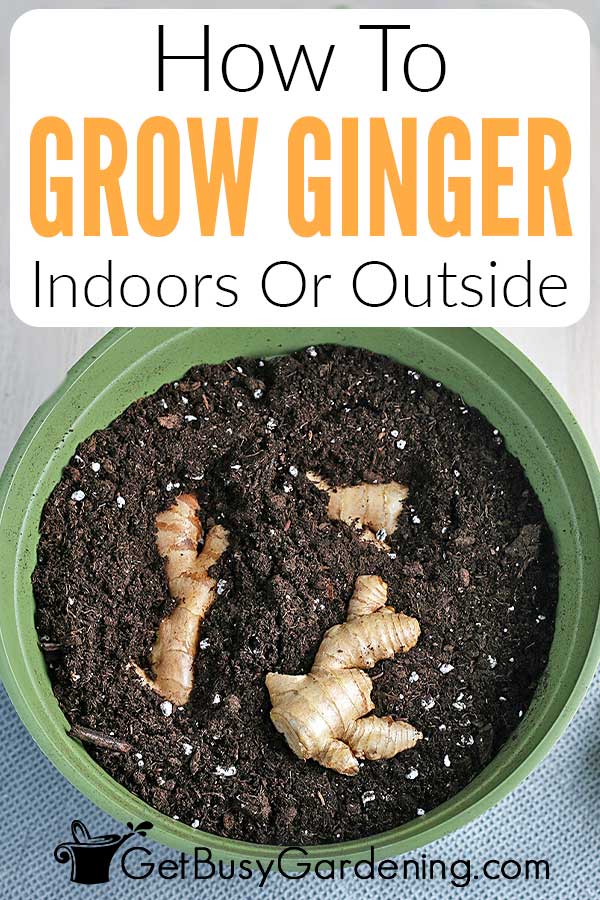
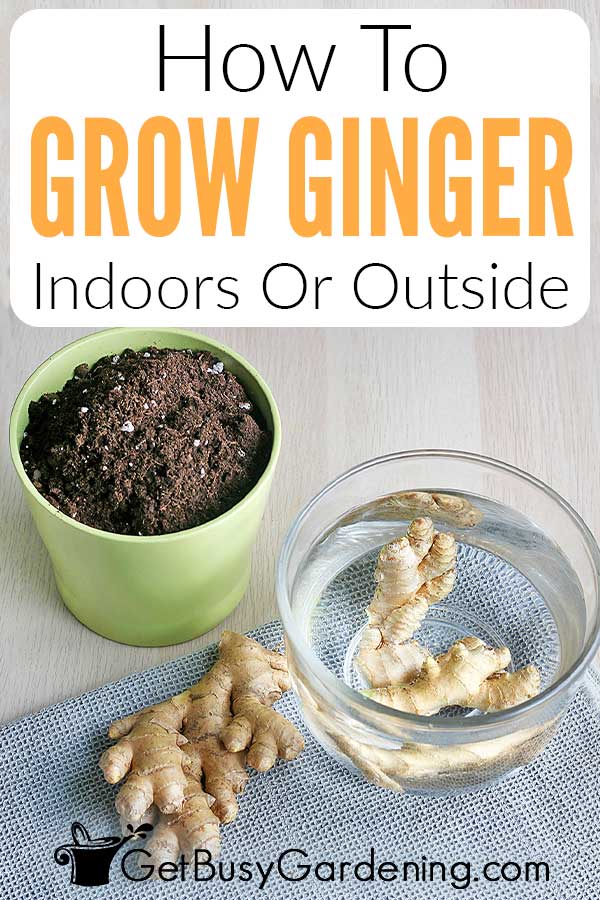
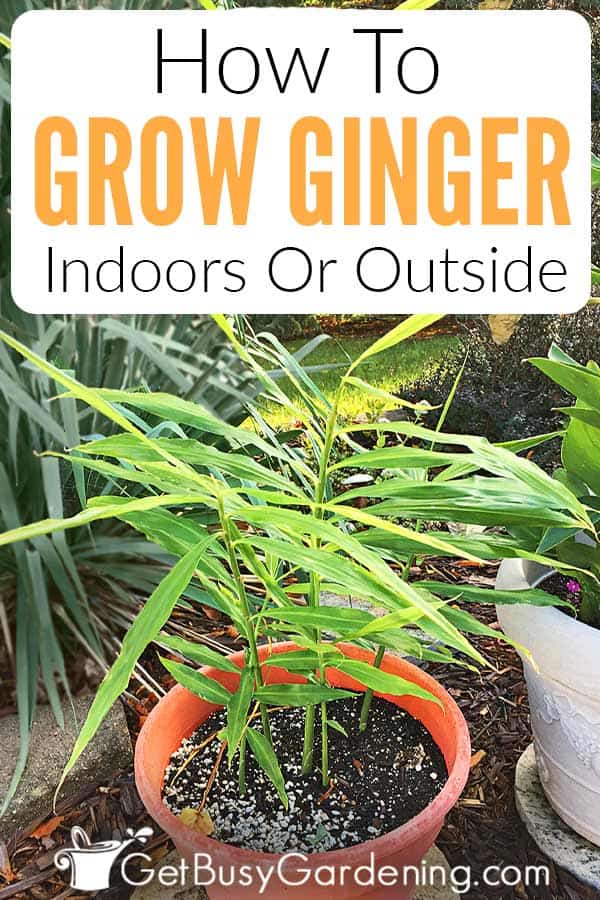


sandra says
I bought some ginger root last week it’s been growing in a plastic lid in the kitchen no soil the only moisture is in the air. I have two the are growing good and two that are just starting to come out. i plan on getting soil and perlite from granddaughter this weekend. Now i have a question i have a 5 gal bucket is that too big? I usually take soda cans and turn them upside down so the water doesn’t go inside and cause root rot is that okay?
Amy Andrychowicz says
A 5 gallon bucket will work for growing your ginger roots – but make sure it has drainage holes in the bottom! Good luck! 🙂
Deb says
I am growing ginger inside in pots. They are growing nice and tall! My problem is that there are small black bugs and small white bugs in the soil. The bugs are very small, but it seems there are sooo many. I refuse to check the soil dampness with my finger. Nope. Not doing it. This is my first experience growing ginger and I don’t know what to do.
Amy Andrychowicz says
Those bugs are likely fungus gnats, and a common sign that you’re overwatering. First you should make sure the soil dries at least 2″ deep before watering again, or the rhizomes could rot. Here’s how to get rid of the bugs.
Alex Harris says
My ginger stem is falling over. The leaves did get brown on the tips and I started watering more frequently, but stems need support.
Amy Andrychowicz says
When ginger stems fall over, it could be a few things. Consistent overwatering will causes the rhizomes to rot and the stems to fall over. But you said it has brown tips, which makes me think that it wasn’t getting enough water. Underwatering can cause the rhizomes to go dormant, which means the foliage will die back. So the first thing to do is check the soil to make sure it’s getting the right amount of moisture. But cold exposure can also trigger dormancy and cause brown tips, so it could just be from that.
Conny says
I’m in south east Queensland in Australia. My ginger has gone dormant and the leaves have died off, leaving some of the rhizomes exposed. Should I cover them to prevent them getting exposed to sunlight, and what with? The parts that are underneath the soil are still nice and tender.
Amy Andrychowicz says
When ginger root rhizomes start poking out above the soil, that’s usually an indication that it’s ready to be harvested or divided. If you don’t want to do either of those, then you could cover them with soil or mulch to protect them from sun/cold damage.
Lyn says
G’day from down under in oz 😊
I planted out healthy organic ginger rhizomes, they grew really well in organic soil with no pests.
When I harvested I was so disappointed with outcome…… the rhizome was tough and had a mild taste/smell of ginger and was bitter tasting.
I have left one half of crop to growi as I thought it may need more time in soil.
It had been growing for 10 months, finished its flowering, but did not die back.
What makes ginger unpleasant taste and tough ?
I live inland south east coastal side of oz, frost starts very soon, I thought now was perfect time for harvest
Would greatly appyyour feedback
Amy Andrychowicz says
Humm, weird. I’ve never heard of ginger being bitter, that is strange. Do you know which variety you have? There are tons of different types, and some are better grown for their flowers rather than for culinary purposes. All I can think of is that maybe you have an ornamental variety rather than one that’s best for eating. Otherwise, it sounds like you’re doing everything right.
John Freney-Mills says
How do you prune ginger plant .? Do you cut it down to the ground ?
Amy Andrychowicz says
Yes, you can cut your ginger back to the ground in the spring, or just prune off the dead leaves as needed.
Marilyn says
It’s early December here in NYC. Can I plant the ginger root now using a grow light or do I still have to wait till January?
Amy Andrychowicz says
No need to wait until January to plant your ginger root, you can do it in December if you want. Just make sure you can give it plenty of light while it’s growing indoors.
Amrutha says
I have growing ginger indoor for 1.5 months but leaves seem to have become transparent yellow what should I do? Is under watering the problem?
Amy Andrychowicz says
Ginger leaves usually turn yellow when the plant is starting to go into dormancy. If the soil is consistently dry, then yes, that is the problem. To prevent your ginger plant from going dormant, never allow the soil to dry out completely. See the “Dormancy” section in the article above for more details.